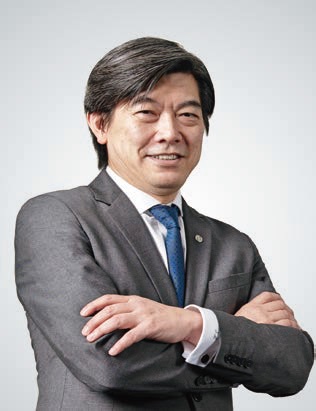5G applications and potentials are too numerous to mention, which explains why a race is on for its development around the world. The huge economic benefit is highly coveted by global players. Some say this is a year for 5G development. Is Hong Kong ready for the new age of 5G networks?
Justin Chuang: 5G Actualizes IoE
 As mobile technology advances in leaps and bounds, the emergence of 5G is an irresistible trend. Justin Chuang, Vice President (Next Generation Network) of Hong Kong Applied Science and Technology Research Institute (ASTRI), stressed that 5G is a technology that delivers massive connectivity to realize the Internet of Everything (IoE). More importantly, 5G is capable of incorporating more I&T framework features into conventional communications technology to achieve great diversity at the application level.
As mobile technology advances in leaps and bounds, the emergence of 5G is an irresistible trend. Justin Chuang, Vice President (Next Generation Network) of Hong Kong Applied Science and Technology Research Institute (ASTRI), stressed that 5G is a technology that delivers massive connectivity to realize the Internet of Everything (IoE). More importantly, 5G is capable of incorporating more I&T framework features into conventional communications technology to achieve great diversity at the application level.
Upgrading to “smart factories”
As the biggest research institute in Hong Kong, ASTRI has been providing technical support for 5G network planning and deployment, such as developing 5G spectrum user solutions and recommending feasible measures to the Communications Authority. As such, ASTRI plays a pivotal role in Hong Kong’s application and development of 5G networks.
Chuang mentioned particularly that at the application level, 5G can support manufacturers to upgrade themselves into “smart factories”, changing the manufacturing landscape completely as a result. “It can be foreseen that the manufacturing industry will no longer need to rely on low-cost labor to produce goods. Instead, support will come from automated technologies that enhance productivity, such as logistics and supply chain management, the Industrial Internet of Things (IIoT), robotics and AI applications.” To promote even wider application of 5G in Hong Kong, ASTRI is working closely with the industrial sector to develop 5G-connected IIoT applications. It is also joining forces with equipment suppliers and operators to drive testing and utilizing a 5G Internet of Vehicles (IoV).
Facilitating smart city development
Today, 5G is a hot research subject in the global mobile communications arena. Chuang pointed out that in the next few years, 5G will move deep into the realm of practical applications. He said countries around the world are making robust efforts to build smart cities, and 5G is a trump card that provides connection to technical support. “Only an integrated smart city which has technologies like autonomous vehicles, intelligent lampposts, the Internet of Things (IoT) and IoV seamlessly connected can maximize its effectiveness. This is the crux of development both for today and the future.”
Among the research projects actively promoted by ASTRI, 5G wireless access is a top priority. This technology covers six aspects: massive multi-input and multioutput (MIMO), centralized-radio access network (C-RAN), ultra-dense network (UDN), machine to machine (M2M), device to device (D2D), and utilization of efficient and dynamic spectrum by emerging systems.
Building a new platform for 5G innovation
At the same time, ASTRI is working on an open 5G innovation platform (5GIP). Promoting and demonstrating ASTRI’s 5G technology to the industry and driving commercialization on one hand, it is strengthening collaboration with the enterprise ecological chain on the other. Integrated and interoperable tests are carried out in an ASTRI-built physical network environment to develop endto-end solutions. Effort is also made to nurture and motivate creative design in Hong Kong. One example is the Smart City Innovation Centre at Science Park, which is a joint effort to push forward technological innovation and application in Hong Kong.
As an integral part of ASTRI’s nextgeneration network initiative – supporting sustained innovation and successful commercialization ― 5GIP will focus on the software-configurability of the network through integrating technologies and products from ASTRI and third parties. It will also develop network orchestration and network slicing features. This project will deliver an advanced 5G network environment to support collaboration between ASTRI and the local community for developing innovative and competitive products.
Sean Lee: CMHK is Making Vigorous Effort to Embrace New Age of 5G
 The Commerce and Economic Development Bureau and the Communications Authority announced the allocation of the first batch of spectrum (4,100 MHz) in the 26 GHz and 28 GHz bands earlier. Telecoms operators can provide the 5th generation (5G) mobile service at hotspots in April at the soonest. It was also announced that spectrum in the 3.5 GHz, 3.3 GHz and 4.9 GHz bands, totaling 380 MHz, will be auctioned batch by batch from the middle of this year. Service is estimated to commence from 2020. Major mobile service providers have also begun testing 5G-related technologies.
The Commerce and Economic Development Bureau and the Communications Authority announced the allocation of the first batch of spectrum (4,100 MHz) in the 26 GHz and 28 GHz bands earlier. Telecoms operators can provide the 5th generation (5G) mobile service at hotspots in April at the soonest. It was also announced that spectrum in the 3.5 GHz, 3.3 GHz and 4.9 GHz bands, totaling 380 MHz, will be auctioned batch by batch from the middle of this year. Service is estimated to commence from 2020. Major mobile service providers have also begun testing 5G-related technologies.
All tests completed and ready to go
In as early as March 2018, China Mobile Hong Kong (CMHK) became the first mobile network service provider in Hong Kong to obtain the Trial Permit for 5G Test. 5G tests conducted in 5G spectrum have been underway since then. In June 2018, 3.5 GHz and 28 GHz base stations and a 5G core network were installed in the Hong Kong Open Lab to proceed with technical trials based on the NSA 5G network framework. In July, CMHK was the first to complete end-to-end lab testing for 5G networks. End-to-end means using a 5G wireless router to convert the 5G network to Wi-Fi, enabling a smooth and fast web browsing experience by connecting to the 5G network on a computer or mobile terminal.
Following successful testing in the lab environment, CMHK began installing three 28 GHz 5G base stations in Hong Kong Science Park in October 2018, making it the first local network service provider to carry out 5G network commercial equipment tests in an urban setting. By the end of 2018, all technical tests were completed. At present, the three 5G base stations can provide outdoor coverage to most parts of Science Park Phase 2. This is instrumental in developing different applications and testing which will in turn promote Hong Kong’s transformation into a smart city. Meanwhile, CMHK is making preparations in earnest for testing midband and low-band 5G networks. A 3.5 GHz commercial 5G base station has been installed on the roof of its Mongkok flagship store to test 5G network performance in a densely populated district.

In addition to testing with spectrum, CMHK was also the first to cloud its core network by introducing network function virtualization (NFV) in the existing 4.5G network. NFV is a key 5G technology. Its introduction marks an important step in CMHK’s development of the 5G network.
4G changes our way of life; 5G changes the way of society
According to Sean Lee, Director and Chief Executive Officer of CMHK, CMHK will continue to install 5G base stations for testing in different districts. This can help ensure 5G service is available to mobile users in Hong Kong as soon as possible when the 5G spectrum licenses are awarded.
When asked about what changes we can expect in business operations and everyday life in the upcoming 5G new age, Lee thinks “while 4G changes our way of life, 5G changes the way of society”. He pointed out that with capabilities to support massive device connectivity and featuring low latency, 5G networks can bolster the development of the Internet of Things (IoT) and the realization of the Internet of Everything (IoE). 5G applications cover many different aspects, including smart driving, smart street lamps, smart home, smart medicine and smart society. They will drive the automation and intelligentization of more and more services. Some industries which require heavy manpower or manual operation today can be revolutionized by cloud robots and AI. Apart from enhancing efficiency and reliability, they can also redeploy manpower and make best use of resources.
Wide application and endless business opportunities
Working in conjunction with IoT, high-speed and low-latency 5G networks will engender more sizeable application of big data. Lee cited an example that in the future remote medical diagnosis may be possible and smart driving may be more popular. In a nutshell, 5G will create new opportunities for all industries and sectors. Big data generated by a large number of devices leads to bigger scale, and service providers will have more exact understanding of user activities to offer more customized user experience.
In addition to being a cradle for IoE, 5G networks have another important feature ― narrowband IoT (NB-IoT). As Lee explained, NB-IoT is a cellular-networkbased IoT technology that supports connectivity of large numbers of lowpower-consumption devices to existing mobile networks at lower deployment costs. Relative to other IoT technologies, NB-IoT has three technical advantages, namely, extensive coverage, low cost, and massive connectivity. CMHK is the first local mobile network operator to release NB-IoT for business in Hong Kong, using this technology to help Hong Kong gather pace in building a smart city and further the development of IoT in the SAR.
The SAR Government has identified six key areas ― smart mobility, smart living, smart environment, smart people, smart government, and smart economy ― in Smart City Blueprint for Hong Kong. Lee feels that developing 5G for business presents a great opportunity to putting these smart applications into practice.
Hendrick Sin: First Year of 5G Commercialization Kicks Off
 Hendrick Sin, President of the Internet Professional Association, said that many advanced economies worldwide have announced timetables and frequency band auctions for 5G commercialisation late last year and various mobile phone manufacturers plan to launch 5G mobile phones during the year, thus kicking off the first year of 5G commercialisation.
Hendrick Sin, President of the Internet Professional Association, said that many advanced economies worldwide have announced timetables and frequency band auctions for 5G commercialisation late last year and various mobile phone manufacturers plan to launch 5G mobile phones during the year, thus kicking off the first year of 5G commercialisation.
“Given the continuous development of artificial intelligence (AI), industrial Internet and Internet of Things (IoT), 5G is regarded as one of the new key economic growth drivers going forward. Some foreign research institutions projected that 5G could generate USD12.3 trillion in benefits and create about 22 million jobs globally by 2035.” Sin believes that the beginning of 5G commercialization will lead to a significant breakthrough in 5G network development this year, but due to various factors such as fees, base station construction and 5G terminals, it still has a long way to go before large-scale adoption.
Global 5G race is on
Sin further explained that at the current stage, the challenges facing the industry are mainly associated with diversified commercial applications and high investment costs. The key reason is that 5G networks will use millimetre wave, which is a band of radio frequencies for transmission. This band has the advantages of high speed and high bandwidth, but it also has the disadvantages of high loss-rate and short transmission range, resulting in 5G base stations having a smaller coverage area than base stations of the past. Therefore, 5G networks need higher density of small base stations, which greatly increases investment costs. Sin also pointed out the challenges for 5G: “Although 5G has many outstanding merits, the currently widely adopted 4G meets user needs to a great extent, so user demand for 5G has to be stimulated through more commercial applications or mobile consumer experience.”
5G networks emphasise fast and reliable data transmission, and various countries are currently accelerating the construction of transmitting stations. According to a study conducted by consulting firm Deloitte, China ranks second after Japan in terms of number of transmitting stations per 10,000 people. Sin said that various advanced economies are striving to take initiative in 5G development. South Korea was the first to announce large-scale 5G commercialisation last December, while the US, Japan and the UK indicated that they will begin 5G commercialisation this year. As for China, it has always been at the forefront of 5G development.
China’s outstanding performance
“In early 2019, the Ministry of Industry and Information Technology clearly stated that it will speed up 5G commercialisation and will likely issue temporary 5G licenses (i.e. pre-commercialisation licenses) in the first half of this year to first commercialise 5G in several pilot cities; it will promote terminals such as 5G mobile phones and 5G tablets in the second half of the year; and full commercialisation could be achieved by 2020.” Sin added that the three major telecom carriers in the Mainland are now ready for pre-commercialisation of 5G, and in conjunction with national policies, the number of base stations in the Mainland is expected to rapidly increase along with commercialization.
In terms of network development, China has evolved from its past role as a “follower” to a strong global “competitor”. Sin stressed that Huawei has a great chance to become the world’s largest supplier of base station equipment. This January, Huawei revealed that it has received 30 orders for 5G commercialisation. In addition, it has delivered more than 25,000 5G base stations worldwide. Huawei has highly competitive products ranging from chips, base stations to mobile terminals. Its superb technology will enable it to gain global recognition and the problems it is currently facing will not have a very big impact.”
Hong Kong keeping pace with 5G
Referring to 5G development in Hong Kong, Sin is glad to see the HKSAR Government has plans to equip 400 smart lamp posts with 5G facilities in four urban locations. The Policy Address of 2018 also proposed to open up suitable government venues and rooftops for mobile service operators to deploy 5G network base stations, and through the launch of a funding scheme, the optical network will be extended to the remote rural areas of the New Territories and outlying islands. However, he suggested that the government should formulate more policies or plans to assist operators in setting up network stations, such as opening up the locations of street lights.
Sin said that overly high prices would affect people’s willingness to use 5G, so the government should explore subsidising users. “In late last July, the Communications Authority announced that nearly 4,500 MHz of 5G spectrum will be made available to the market as soon as in the first half of this year, some of which will be provided free of charge. Based on the current schedules, Hong Kong is not too far behind the leading regions in rolling out 5G commercialisation, and injecting more innovative elements at the application level will help Hong Kong’s industry seize the initiative in 5G competition.”
“Internet of Everything” coming true
Sin pointed out that 5G adoption and commercialization will lead to big changes to the daily life of the public. For example, mature AI technologies can promote the adoption of unmanned driving; low latency can drive the development of telemedicine to alleviate the stress on the healthcare system caused by ageing population; and 5G can help expand industry-level IoT to consumer-level IoT and promote the sustainable development of smart wearables and smart homes. He stressed that the adoption of 5G networks will play a significant role not only for information transmission between “people and people”, but also between “things and things” and “things and people”, thus achieving “Internet of Everything”.




